The Effects of Green and Urban Walking in Different Time Frames on Physio-Psychological Responses of Middle-Aged and Older People in Chengdu, China
Abstract
1. Introduction
- (1)
- The daytime urban walking has negative effects while the nighttime urban walking has positive effects on the investigated psychological and physiological responses;
- (2)
- The daytime green walking has positive effects while the nighttime green walking has negative effects;
- (3)
- Compared to the nighttime green walking, the urban walking has greater positive effects and is more attractive to urban citizens.
2. Materials and Methods
2.1. Participants
- (1)
- Aged between 40 and 75 years.
- (2)
- Absence of serious cardiovascular disease.
- (3)
- Absence of chronic symptoms causing walking problems.
- (4)
- Absence of cognitive impairment and mental disorders.
- (1)
- Daytime green walking (DG).
- (2)
- Nighttime green walking (NG).
- (3)
- Daytime urban walking (DU).
- (4)
- Nighttime urban walking (NU).
2.2. Study Sites
2.3. Process and Contents of Walking Experiment
2.4. Measurement of the Outcomes
2.4.1. Physiological Parameters
2.4.2. Psychological Parameters
2.5. Statistical Methods
3. Results
3.1. Validation of the Psychological Measurements
3.2. Pyschological Outcomes of Walking in Different Scenarios
3.3. Restorativeness of Different Walking Environments
3.4. Physiological Outcomes of Walking in Different Scenarios
3.5. Walking Environment Preference of Participants
4. Discussion
4.1. Urban Walking
4.2. Green Walking
4.3. Nighttime Walking
4.4. Limitations
5. Conclusions
Author Contributions
Funding
Institutional Review Board Statement
Informed Consent Statement
Data Availability Statement
Acknowledgments
Conflicts of Interest
References
- Okkels, N.; Kristiansen, C.B.; Munk-Jørgensen, P.; Sartorius, N. Urban mental health: Challenges and perspectives. Curr. Opin. Psychiatry 2018, 31, 258–264. [Google Scholar] [CrossRef] [PubMed]
- Ulrich, R.S.; Simons, R.F.; Losito, B.D.; Fiorito, E.; Zelson, M. Stress recovery during exposure to natural and urban environments. J. Environ. Psychol. 1991, 11, 201–230. [Google Scholar] [CrossRef]
- Hahad, O.; Kröller-Schön, S.; Daiber, A.; Münzel, T. The Cardiovascular Effects of Noise. Dtsch. Arztebl. Int. 2019, 116, 245–250. [Google Scholar] [CrossRef] [PubMed]
- Armstrong, A.D.C.; Ladeia, A.M.T.; Marques, J.; Armstrong, D.; Silva, A.; Morais Junior, J.C.; Barral, A.; Correia, L.C.L.; Barral-Netto, M.; Lima, J.A.C. Urbanization is Associated with Increased Trends in Cardiovascular Mortality Among Indigenous Populations: The PAI Study. Arq. Bras. Cardiol. 2018, 110, 240–245. [Google Scholar] [CrossRef] [PubMed]
- Wang, R.; Xue, D.; Liu, Y.; Chen, H.; Qiu, Y. The relationship between urbanization and depression in China: The mediating role of neighborhood social capital. Int. J. Equity Health 2018, 17, 105. [Google Scholar] [CrossRef] [PubMed]
- Koselka, E.P.D.; Weidner, L.C.; Minasov, A.; Berman, M.G.; Leonard, W.R.; Santoso, M.V.; de Brito, J.N.; Pope, Z.C.; Pereira, M.A.; Horton, T.H. Walking Green: Developing an Evidence Base for Nature Prescriptions. Int. J. Environ. Res. Public Health 2019, 16, 4338. [Google Scholar] [CrossRef]
- Trøstrup, C.H.; Christiansen, A.B.; Stølen, K.S.; Nielsen, P.K.; Stelter, R. The effect of nature exposure on the mental health of patients: A systematic review. Qual. Life Res. 2019, 28, 1695–1703. [Google Scholar] [CrossRef]
- Repke, M.A.; Berry, M.S.; Conway, L.G., 3rd; Metcalf, A.; Hensen, R.M.; Phelan, C. How does nature exposure make people healthier?: Evidence for the role of impulsivity and expanded space perception. PLoS ONE 2018, 13, e0202246. [Google Scholar] [CrossRef]
- Agüera Sánchez, M.; Barbancho Ma, M.; García-Casares, N. Effect of physical exercise on Alzheimer’s disease. A sistematic review. Aten. Primaria 2020, 52, 307–318. [Google Scholar] [CrossRef]
- Marker, A.M.; Steele, R.G.; Noser, A.E. Physical activity and health-related quality of life in children and adolescents: A systematic review and meta-analysis. Health Psychol. 2018, 37, 893–903. [Google Scholar] [CrossRef]
- Shanahan, D.F.; Franco, L.; Lin, B.B.; Gaston, K.J.; Fuller, R.A. The Benefits of Natural Environments for Physical Activity. Sports Med. 2016, 46, 989–995. [Google Scholar] [CrossRef] [PubMed]
- Pratiwi, P.I.; Xiang, Q.; Furuya, K. Physiological and Psychological Effects of Walking in Urban Parks and Its Imagery in Different Seasons in Middle-Aged and Older Adults: Evidence from Matsudo City, Japan. Sustainability 2020, 12, 4003. [Google Scholar] [CrossRef]
- Song, C.; Joung, D.; Ikei, H.; Igarashi, M.; Aga, M.; Park, B.-J.; Miwa, M.; Takagaki, M.; Miyazaki, Y. Physiological and psychological effects of walking on young males in urban parks in winter. J. Physiol. Anthropol. 2013, 32, 18. [Google Scholar] [CrossRef] [PubMed]
- Ji, G.; Kim, K.; Han, G.-S. Physiological and Psychological Effects of Viewing and Walking in Forest and Urban Area. J. Environ. Sci. 2012, 21, 605–611. [Google Scholar] [CrossRef]
- Kobayashi, H.; Song, C.; Ikei, H.; Park, B.J.; Lee, J.; Kagawa, T.; Miyazaki, Y. Forest Walking Affects Autonomic Nervous Activity: A Population-Based Study. Front. Public Health 2018, 6, 278. [Google Scholar] [CrossRef]
- Li, Q.; Otsuka, T.; Kobayashi, M.; Wakayama, Y.; Inagaki, H.; Katsumata, M.; Hirata, Y.; Li, Y.; Hirata, K.; Shimizu, T.; et al. Acute effects of walking in forest environments on cardiovascular and metabolic parameters. Eur. J. Appl. Physiol. 2011, 111, 2845–2853. [Google Scholar] [CrossRef] [PubMed]
- Lee, J.Y.; Lee, D.C. Cardiac and pulmonary benefits of forest walking versus city walking in elderly women: A randomised, controlled, open-label trial. Eur. J. Integr. Med. 2014, 6, 5–11. [Google Scholar] [CrossRef]
- Karmanov, D.; Hamel, R. Assessing the restorative potential of contemporary urban environment(s): Beyond the nature versus urban dichotomy. Landsc. Urban Plan. 2008, 86, 115–125. [Google Scholar] [CrossRef]
- Pretty, J.; Peacock, J.; Sellens, M.; Griffin, M. The mental and physical health outcomes of green exercise. Int. J. Environ. Health Res. 2005, 15, 319–337. [Google Scholar] [CrossRef]
- Paulina, K.; Katarzyna, B. Restorative Qualities of and Preference for Natural and Urban Soundscapes. Front. Psychol. 2017, 8, 1705. [Google Scholar]
- Yang, M. A study on characteristics of middle and advanced-aged people’s exercise in scenic resorts. J. Beijing Sport Univ. 2009, 32, 54–56. [Google Scholar]
- Pang, Y.N.; He, J.W. Sports participation of Chinese people of different ages. China Sport Sci. 2000, 20, 23–25. [Google Scholar]
- Brito, L.C.; Peçanha, T.; Fecchio, R.Y.; Rezende, R.A.; Sousa, P.; Silva-Júnior, N.D.; Abreu, A.; Silva, G.; Mion-Junior, D.; Halliwill, J.R.; et al. Morning versus Evening Aerobic Training Effects on Blood Pressure in Treated Hypertension. Med. Sci. Sports Exerc. 2019, 51, 653–662. [Google Scholar] [CrossRef] [PubMed]
- Fullick, S.; Morris, C.; Jones, H.; Atkinson, G. Prior exercise lowers blood pressure during simulated night-work with different meal schedules. Am. J. Hypertens. 2009, 22, 835–841. [Google Scholar] [CrossRef] [PubMed]
- Miller, D.J.; Sargent, C.; Roach, G.D.; Scanlan, A.T.; Vincent, G.E.; Lastella, M. Moderate-intensity exercise performed in the evening does not impair sleep in healthy males. Eur. J. Sport Sci. 2020, 20, 80–89. [Google Scholar] [CrossRef] [PubMed]
- Li, Z.Q.; Dai, X.; Guo, L. Investigation and reflection on morning and evening exercise groups in Guangzhou. J. Phys. Educ. 1998, 1, 23–25. [Google Scholar]
- Gong, J.W. Investigation on Present Situation and Analysis on Main Factors Affecting Activity2takers in the Morning and Evening Exercise Spots in Nanjing City. J. Shenyang Sport Univ. 2008, 27, 83–86. [Google Scholar]
- Larkin, A.; Hystad, P. Evaluating street view exposure measures of visible green space for health research. J. Expo. Sci. Environ. Epidemiol. 2019, 29, 447–456. [Google Scholar] [CrossRef]
- Hunter, R.F.; Cleland, C.; Cleary, A.; Droomers, M.; Wheeler, B.W.; Sinnett, D.; Nieuwenhuijsen, M.J.; Braubach, M. Environmental, health, wellbeing, social and equity effects of urban green space interventions: A meta-narrative evidence synthesis. Environ. Int. 2019, 130, 104923. [Google Scholar] [CrossRef]
- Wooller, J.J.; Rogerson, M.; Barton, J.; Micklewright, D.; Gladwell, V. Can Simulated Green Exercise Improve Recovery From Acute Mental Stress? Front. Psychol. 2018, 9, 2167. [Google Scholar] [CrossRef]
- Briki, W.; Majed, L. Adaptive Effects of Seeing Green Environment on Psychophysiological Parameters When Walking or Running. Front. Psychol. 2019, 10, 252. [Google Scholar] [CrossRef] [PubMed]
- Devi, B.; Bhardwaj, D.R.; Panwar, P.; Pal, S.; Gupta, N.K.; Thakur, C.L. Carbon allocation, sequestration and carbon dioxide mitigation under plantation forests of north western Himalaya, India. Ann. For. Res. 2013, 56, 44–50. [Google Scholar]
- Tähkämö, L.; Partonen, T.; Pesonen, A.K. Systematic review of light exposure impact on human circadian rhythm. Chronobiol. Int. 2019, 36, 151–170. [Google Scholar] [CrossRef] [PubMed]
- Tang, Y.Y.; Tang, R.; Posner, M.I. Mindfulness meditation improves emotion regulation and reduces drug abuse. Drug Alcohol Depend. 2016, 163 (Suppl. 1), S13–S18. [Google Scholar] [CrossRef]
- Saxon, L.; Henriksson, S.; Kvarnström, A.; Hiltunen, A.J. Affective Changes During Cognitive Behavioural Therapy-As Measured by PANAS. Clin. Pract. Epidemiol. Ment. Health CP EMH 2017, 13, 115–124. [Google Scholar] [CrossRef]
- Watson, D.; Clark, L.A.; Tellegen, A. Development and validation of brief measures of positive and negative affect: The PANAS scales. J. Personal. Soc. Psychol. 1988, 54, 1063–1070. [Google Scholar] [CrossRef]
- Crawford, J.R.; Henry, J.D. The positive and negative affect schedule (PANAS): Construct validity, measurement properties and normative data in a large non-clinical sample. Br. J. Clin. Psychol. 2004, 43, 245–265. [Google Scholar] [CrossRef]
- Huang, L.; Yang, T.Z.; Ji, Z.M. Applicability of positive and negative scale in Chinese population. Chin. J. Ment. Health 2003, 17, 54–56. [Google Scholar]
- Wang, J.P.; Lin, W.J.; Chen, J.G.; Cui, J.N.; Liu, J. A trial report of the brief mood scale (POMS) in China. J. Psychol. 2000, 32, 110–114. [Google Scholar]
- Zhang, W.Y. Applicability of POMS scale on mood state of female college students during physical entertainment. J. Xian Phys. Educ. Univ. 2009, 26, 508–512. [Google Scholar]
- Berto, R. The role of familiarity on the restorative value of a place. Research on a Spanish sample. IAPS Bull. 2001, 18, 22–24. [Google Scholar]
- Ruiz, C.; Hernandez, B. Emotions and coping strategies during an episode of volcanic activity and their relations to place attachment. J. Environ. Psychol. 2014, 38, 279–287. [Google Scholar] [CrossRef]
- Hartig, T.; Korpela, K.; Evans, G.W. A measure of restorative quality in environments: Scandinavian Housing and Planning Research. Scand. Hous. Plan. Res. 1997, 14, 175–194. [Google Scholar] [CrossRef]
- Hartig, T.; Korpela, K.; Evans, G.W.; Gärling, T. Validation of a measure of perceived environmental restorativeness. Göteborg Psychol. Rep. 1997, 26, 1–64. [Google Scholar]
- Fátima, N.; Estefanía, H.F.; Stephany, H.; Bernardo, H. Discrimination of Urban Spaces with Different Level of Restorativeness Based on the Original and on a Shorter Version of Hartig et al.’s Perceived Restorativeness Scale. Front. Psychol. 2017, 8, 1735. [Google Scholar]
- Silvennoinen, H. Favorite green, waterside and urban environments, restorative experiences and perceived health in Finland. Health Promot. Int. 2010, 25, 200–209. [Google Scholar]
- Korpela, K.M.; Ylén, M.; Tyrväinen, L.; Silvennoinen, H. Determinants of restorative experiences in everyday favorite places. Health Place 2008, 14, 636–652. [Google Scholar] [CrossRef]
- Hassan, A.; Tao, J.; Li, G.; Jiang, M.; Aii, L.; Jiang, Z.; Liu, Z.; Chen, Q. Effects of Walking in Bamboo Forest and City Environments on Brainwave Activity in Young Adults. Evid. Based Complement. Altern. Med. 2018, 2018, 9653857. [Google Scholar] [CrossRef]
- Song, C.; Ikei, H.; Kagawa, T.; Miyazaki, Y. Effects of Walking in a Forest on Young Women. Int. J. Environ. Res. Public Health 2019, 16, 229. [Google Scholar] [CrossRef]
- Lee, L.L.; Watson, M.C.; Mulvaney, C.A.; Tsai, C.C.; Lo, S.F. The effect of walking intervention on blood pressure control: A systematic review. Int. J. Nurs. Stud. 2010, 47, 1545–1561. [Google Scholar] [CrossRef]
- Kelly, P.; Williamson, C.; Niven, A.G.; Hunter, R.; Mutrie, N.; Richards, J. Walking on sunshine: Scoping review of the evidence for walking and mental health. Br. J. Sports Med. 2018, 52, 800–806. [Google Scholar] [CrossRef]
- Kuehn, B.M. Pollution Exposure Counteracts Exercise Benefits: Exercise in Green Spaces, Pollution Reductions Recommended. Circulation 2018, 137, 1516–1517. [Google Scholar] [CrossRef]
- Dzhambov, A.; Tilov, B.; Markevych, I.; Dimitrova, D. Residential road traffic noise and general mental health in youth: The role of noise annoyance, neighborhood restorative quality, physical activity, and social cohesion as potential mediators. Environ. Int. 2017, 109, 1–9. [Google Scholar] [CrossRef]
- Piepoli, M.; Coats, A.J.; Adamopoulos, S.; Bernardi, L.; Feng, Y.H.; Conway, J.; Sleight, P. Persistent peripheral vasodilation and sympathetic activity in hypotension after maximal exercise. J. Appl. Physiol. 1993, 75, 1807–1814. [Google Scholar] [CrossRef]
- Regecová, V.; Kellerová, E. Effects of urban noise pollution on blood pressure and heart rate in preschool children. J. Hypertens. 1995, 13, 405–412. [Google Scholar] [CrossRef]
- Moshammer, H.; Panholzer, J.; Ulbing, L.; Udvarhelyi, E.; Ebenbauer, B.; Peter, S. Acute Effects of Air Pollution and Noise from Road Traffic in a Panel of Young Healthy Adults. Int. J. Environ. Res. Public Health 2019, 16, 778. [Google Scholar] [CrossRef]
- Graham, J.M.; Janssen, S.A.; Vos, H.; Miedema, H.M. Habitual traffic noise at home reduces cardiac parasympathetic tone during sleep. Int. J. Psychophysiol. 2009, 72, 179–186. [Google Scholar] [CrossRef]
- Sonntag-Öström, E.; Nordin, M.; Lundell, Y.; Dolling, A.; Wiklund, U.; Karlsson, M.; Carlberg, B.; Järvholm, L.S. Restorative effects of visits to urban and forest environments in patients with exhaustion disorder. Urban For. Urban Green. 2014, 13, 344–354. [Google Scholar] [CrossRef]
- Cajochen, C.; Frey, S.; Anders, D.; Späti, J.; Bues, M.; Pross, A.; Mager, R.; Wirz-Justice, A.; Stefani, O. Evening exposure to a light-emitting diodes (LED)-backlit computer screen affects circadian physiology and cognitive performance. J. Appl. Physiol. 2011, 110, 1432–1438. [Google Scholar] [CrossRef]
- Gabel, V.; Maire, M.; Reichert, C.F.; Chellappa, S.L.; Schmidt, C.; Hommes, V.; Viola, A.U.; Cajochen, C. Effects of artificial dawn and morning blue light on daytime cognitive performance, well-being, cortisol and melatonin levels. Chronobiol. Int. 2013, 30, 988–997. [Google Scholar] [CrossRef]
- Song, C.; Ikei, H.; Igarashi, M.; Takagaki, M.; Miyazaki, Y. Physiological and Psychological Effects of a Walk in Urban Parks in Fall. Int. J. Env. Res. Public Health 2015, 12, 14216–14228. [Google Scholar] [CrossRef]
- Janeczko, E.; Bielinis, E.; Wójcik, R.; Woźnicka, M.; Kędziora, W.; Łukowski, A.; Elsadek, M.; Szyc, K.; Janeczko, K. When Urban Environment Is Restorative: The Effect of Walking in Suburbs and Forests on Psychological and Physiological Relaxation of Young Polish Adults. Forests 2020, 11, 591. [Google Scholar] [CrossRef]
- Reeves, A.; Grayhem, R.; Hwang, A.D. Rapid Adaptation of Night Vision. Front. Psychol. 2018, 9, 8. [Google Scholar] [CrossRef] [PubMed]
- Nserat, S.; Al-Musa, A.; Khader, Y.S.; Abu Slaih, A.; Iblan, I. Blood Pressure of Jordanian Workers Chronically Exposed to Noise in Industrial Plants. Int. J. Occup. Environ. Med. 2017, 8, 217–223. [Google Scholar] [CrossRef] [PubMed]
- Dayawansa, S.; Umeno, K.; Takakura, H.; Hori, E.; Tabuchi, E.; Nagashima, Y.; Oosu, H.; Yada, Y.; Suzuki, T.; Ono, T.; et al. Autonomic responses during inhalation of natural fragrance of Cedrol in humans. Auton. Neurosci. Basic Clin. 2003, 108, 79–86. [Google Scholar] [CrossRef] [PubMed]
- Li, Q.; Kobayashi, M.; Inagaki, H.; Hirata, Y.; Li, Y.J.; Hirata, K.; Shimizu, T.; Suzuki, H.; Katsumata, M.; Wakayama, Y.; et al. A day trip to a forest park increases human natural killer activity and the expression of anti-cancer proteins in male subjects. J. Biol. Regul. Homeost. Agents 2010, 24, 157–165. [Google Scholar]
- Tischer, C.; Gascon, M.; Fernández-Somoano, A.; Tardón, A.; Lertxundi Materola, A.; Ibarluzea, J.; Ferrero, A.; Estarlich, M.; Cirach, M.; Vrijheid, M.; et al. Urban green and grey space in relation to respiratory health in children. Eur. Respir. J. 2017, 49, 1502112. [Google Scholar] [CrossRef]
- Morita, E.; Fukuda, S.; Nagano, J.; Hamajima, N.; Yamamoto, H.; Iwai, Y.; Nakashima, T.; Ohira, H.; Shirakawa, T. Psychological effects of forest environments on healthy adults: Shinrin-yoku (forest-air bathing, walking) as a possible method of stress reduction. Public Health 2007, 121, 54–63. [Google Scholar] [CrossRef]
- Shin, J.-W.; Choi, J.-H. The Effects of Single Session Forest Walking on Physiological and Psychological State of Myocardial Infarction Patients. J. People Plants Environ. 2019, 22, 109–118. [Google Scholar] [CrossRef]
- Han, K.T. An Exploration of Relationships Among the Responses to Natural Scenes: Scenic Beauty, Preference, and Restoration. Environ. Behav. 2010, 42, 243–270. [Google Scholar] [CrossRef]
- Buccolieri, R.; Gromke, C.; Sabatino, S.D.; Ruck, B. Aerodynamic effects of trees on pollutant concentration in street canyons. Sci. Total Environ. 2009, 407, 5247–5256. [Google Scholar] [CrossRef]
- Nowak, D.J.; Greenfield, E.J.; Hoehn, R.E.; Lapoint, E. Carbon storage and sequestration by trees in urban and community areas of the United States. Environ. Pollut. 2013, 178, 229–236. [Google Scholar] [CrossRef] [PubMed]
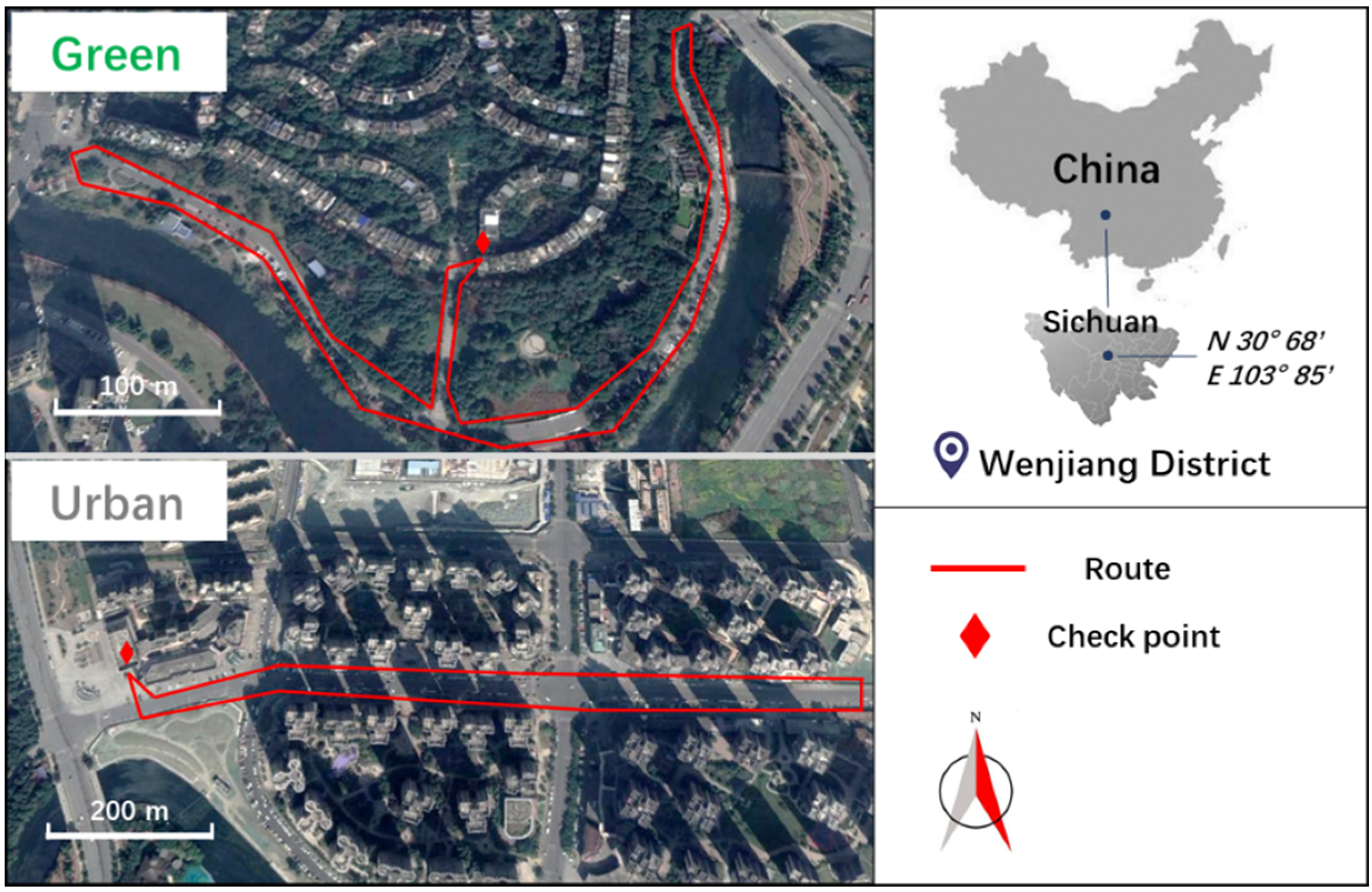
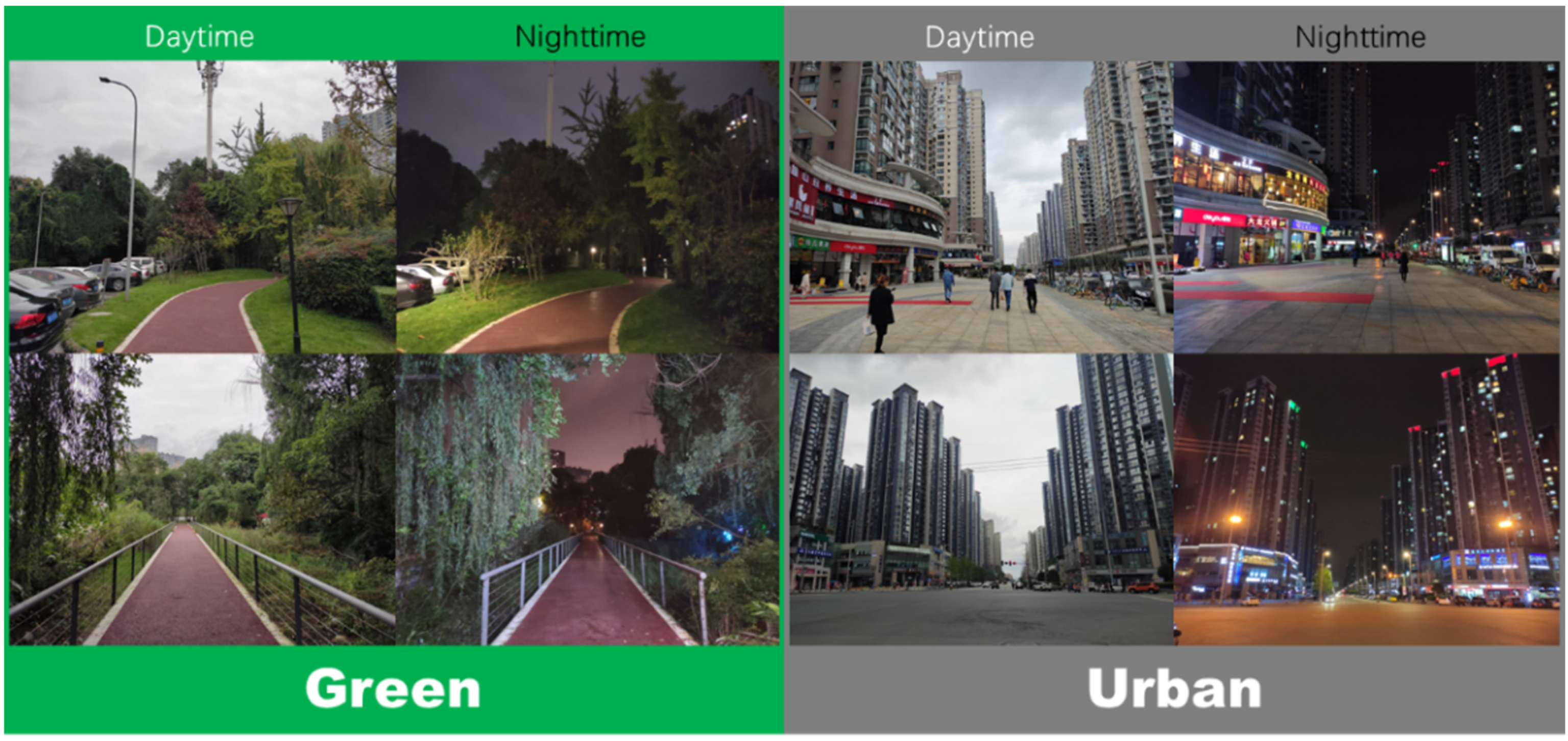
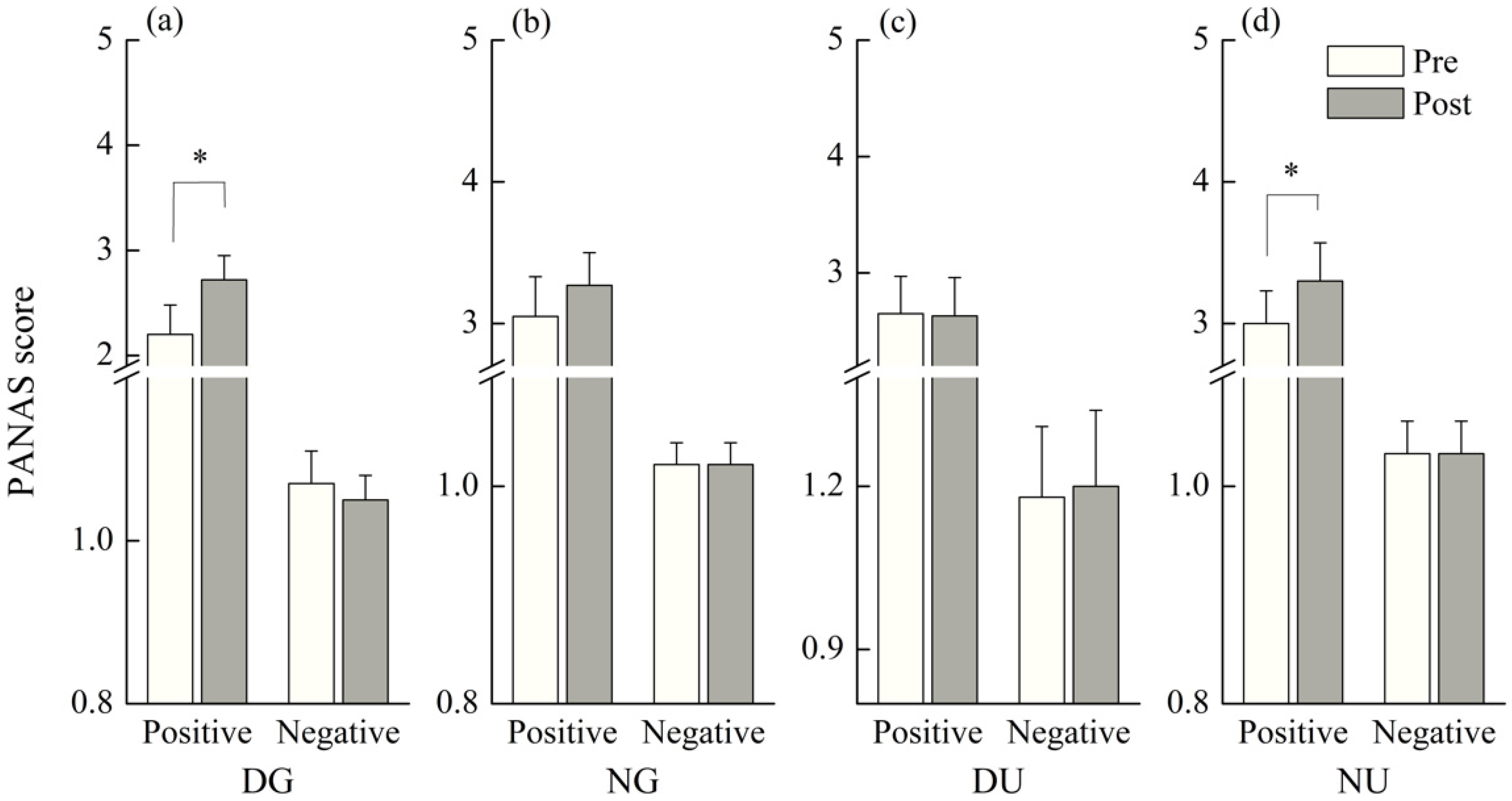
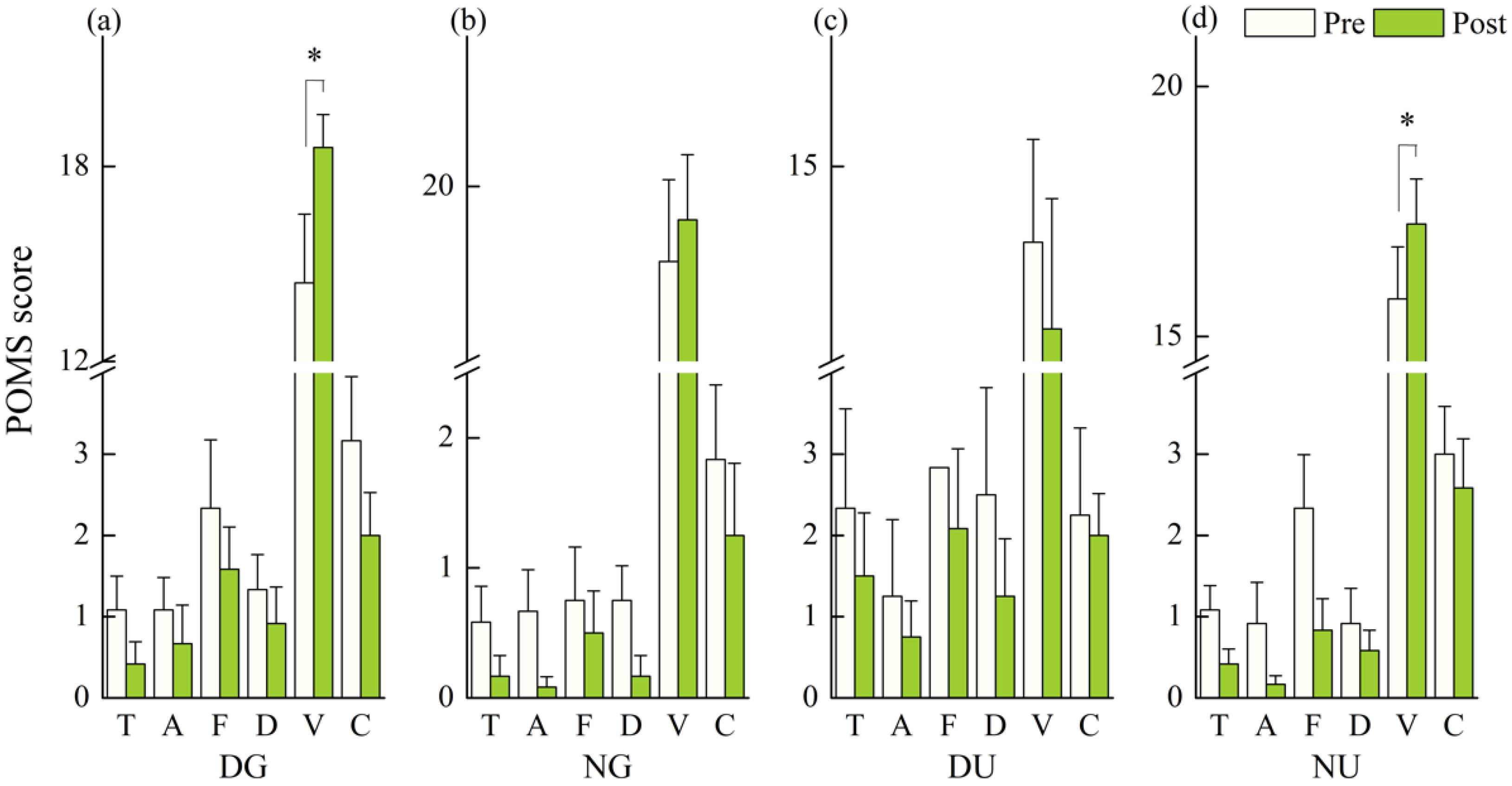
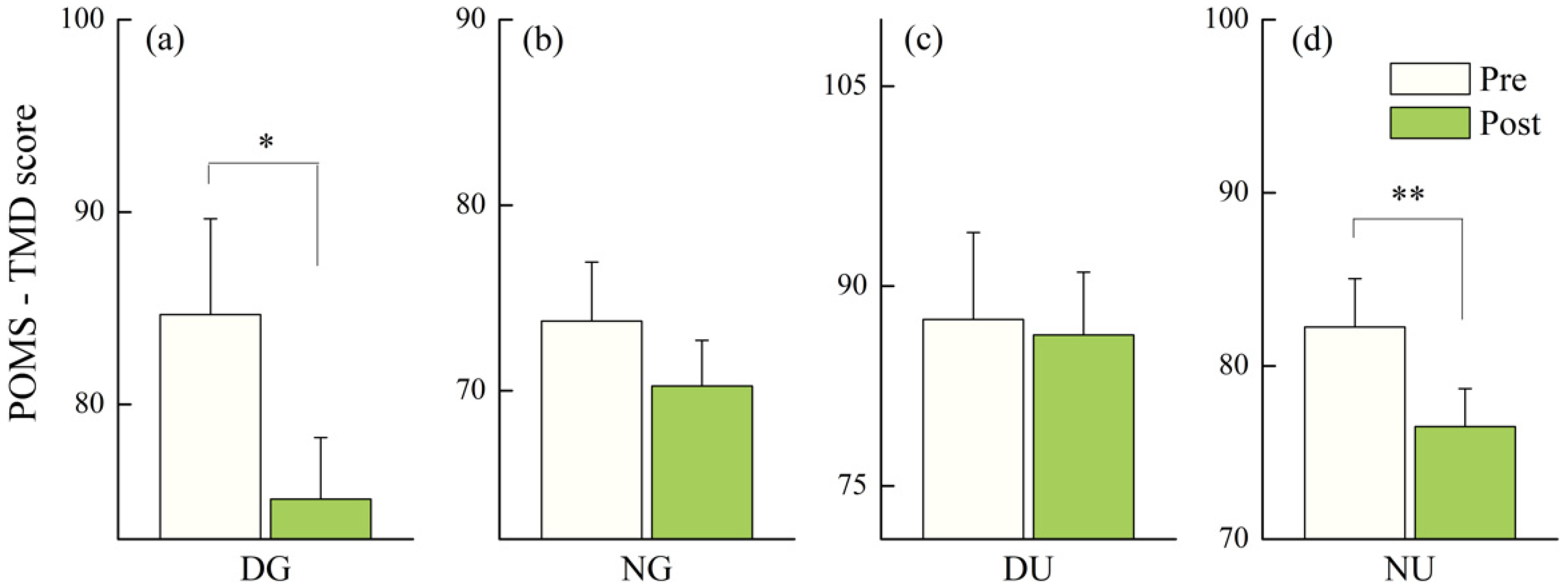
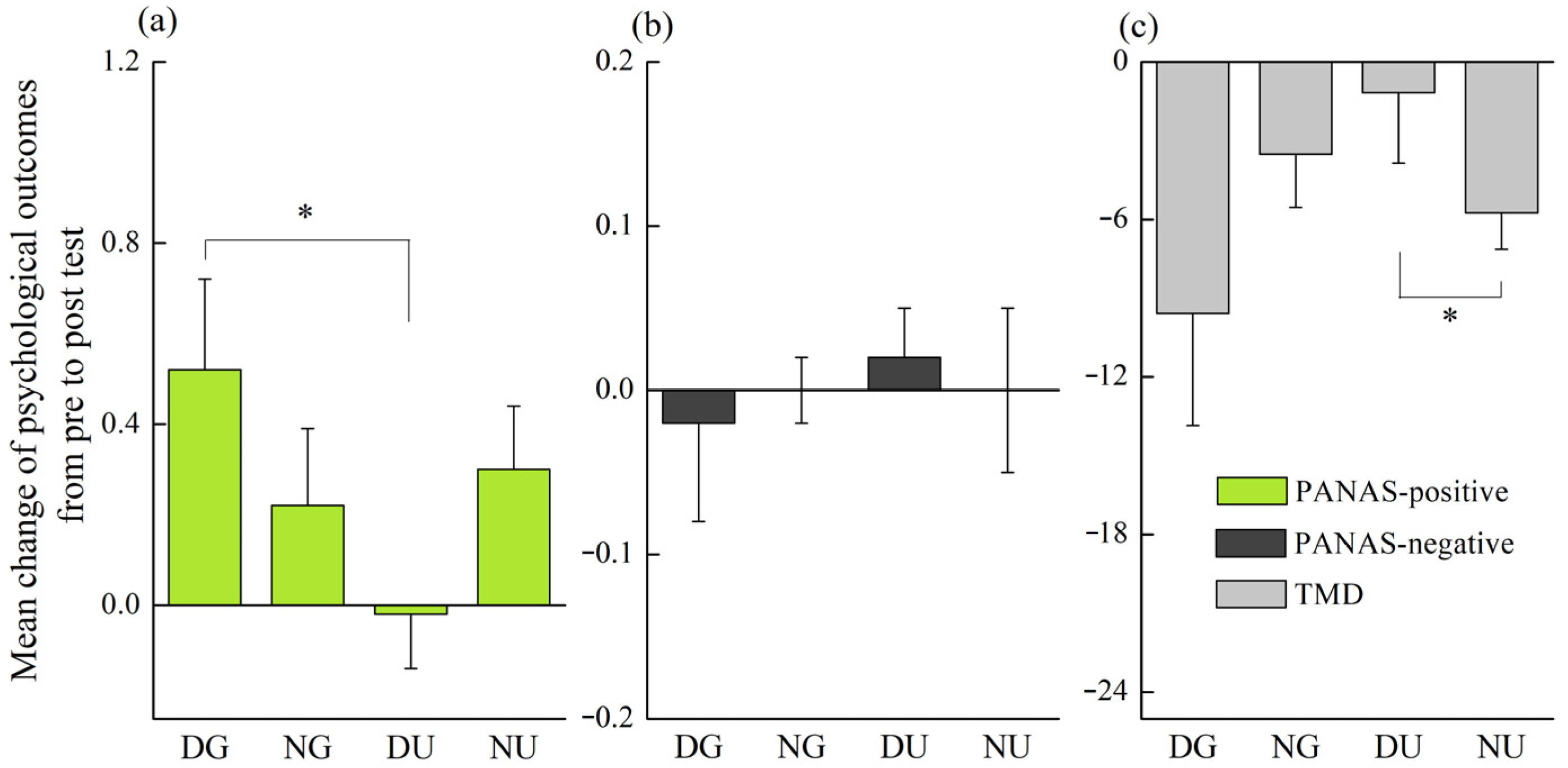
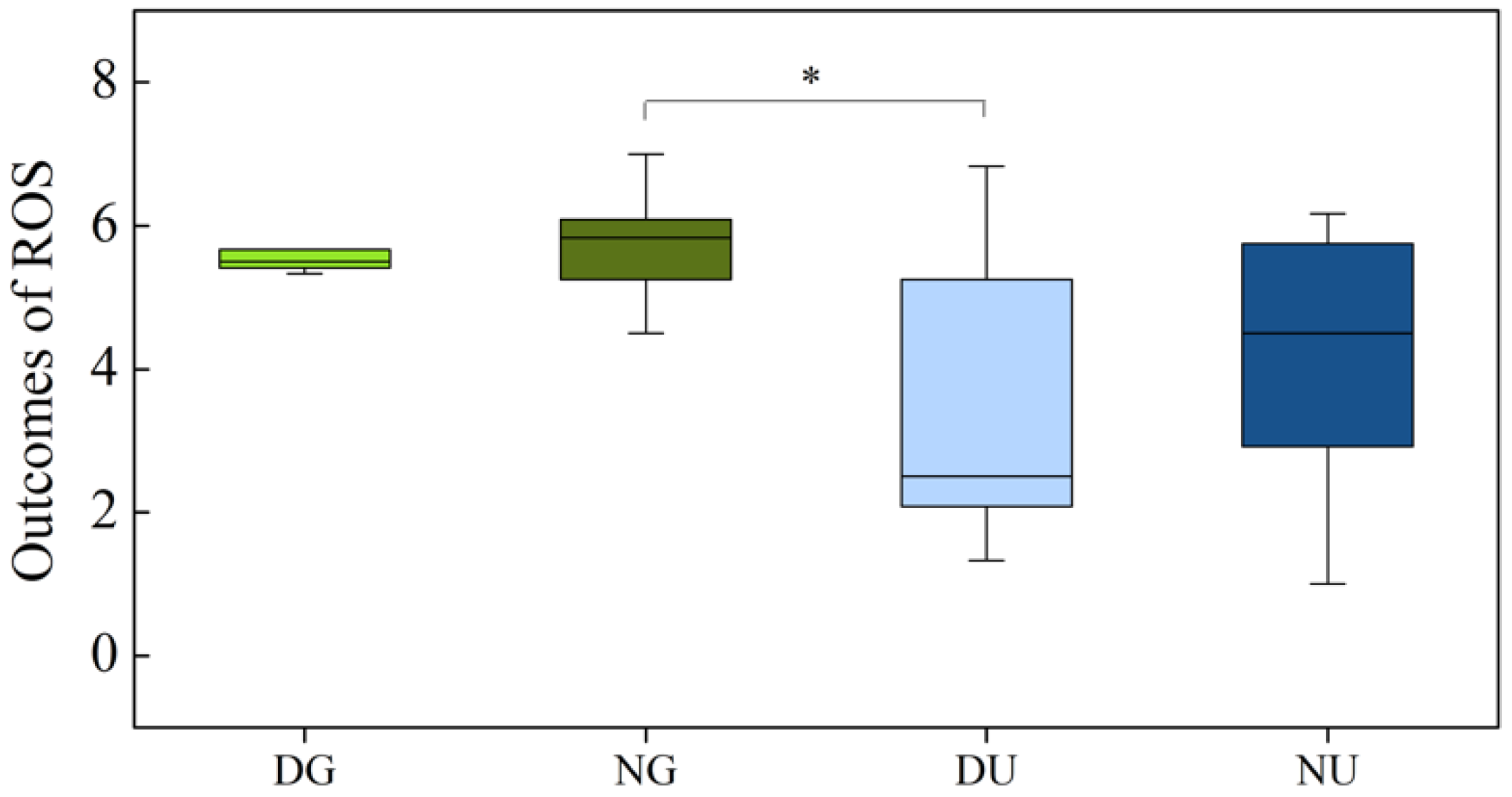
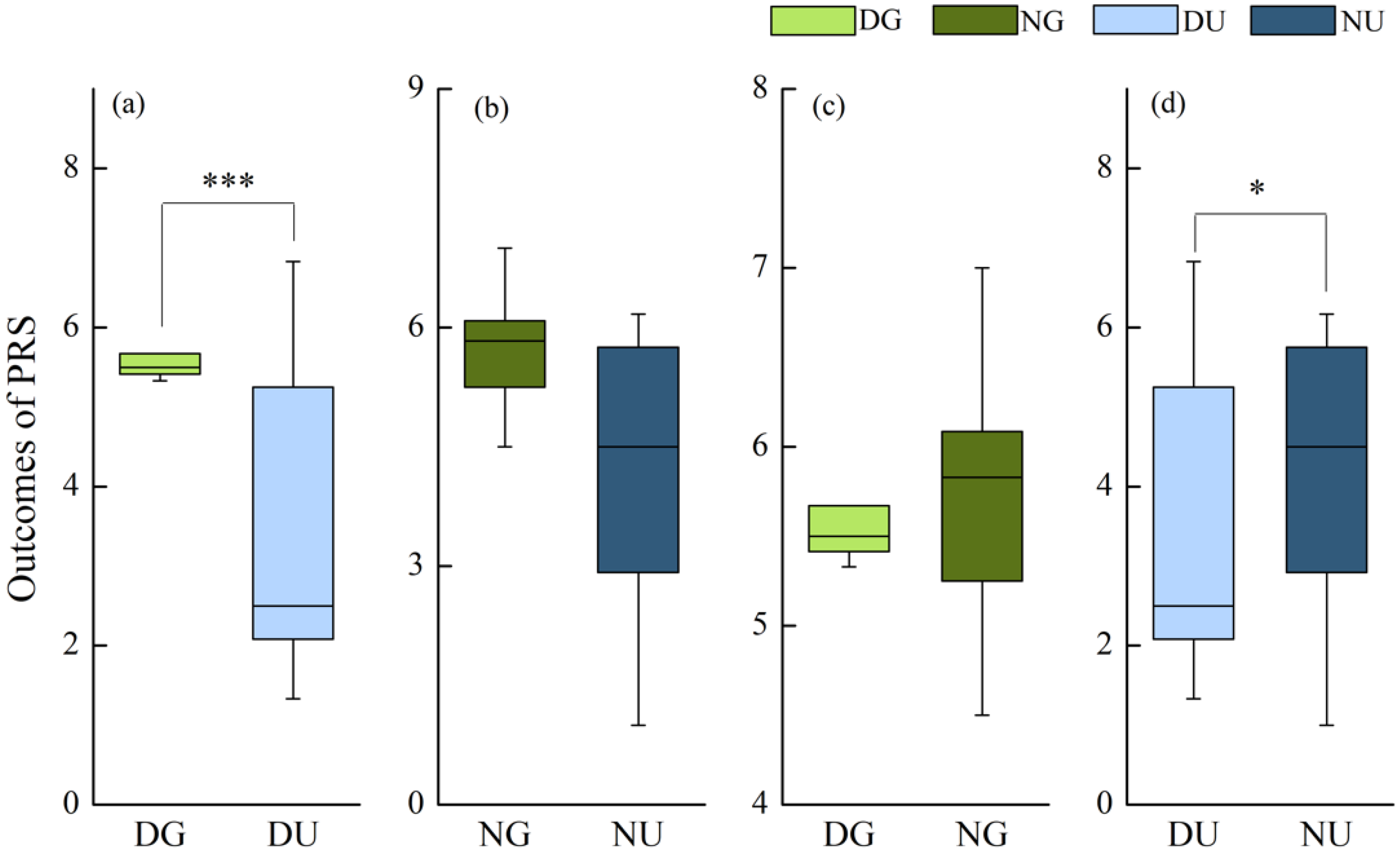
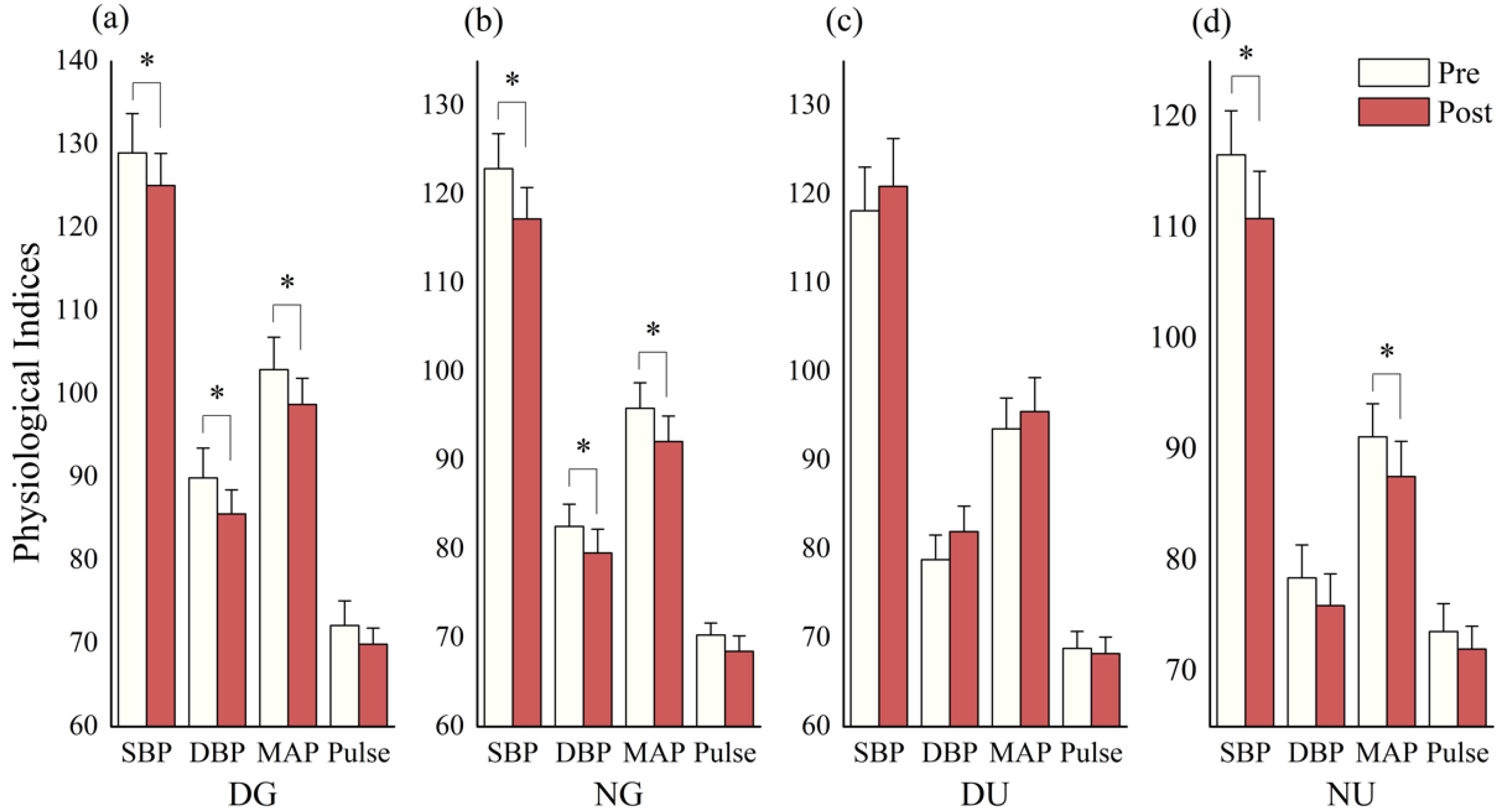
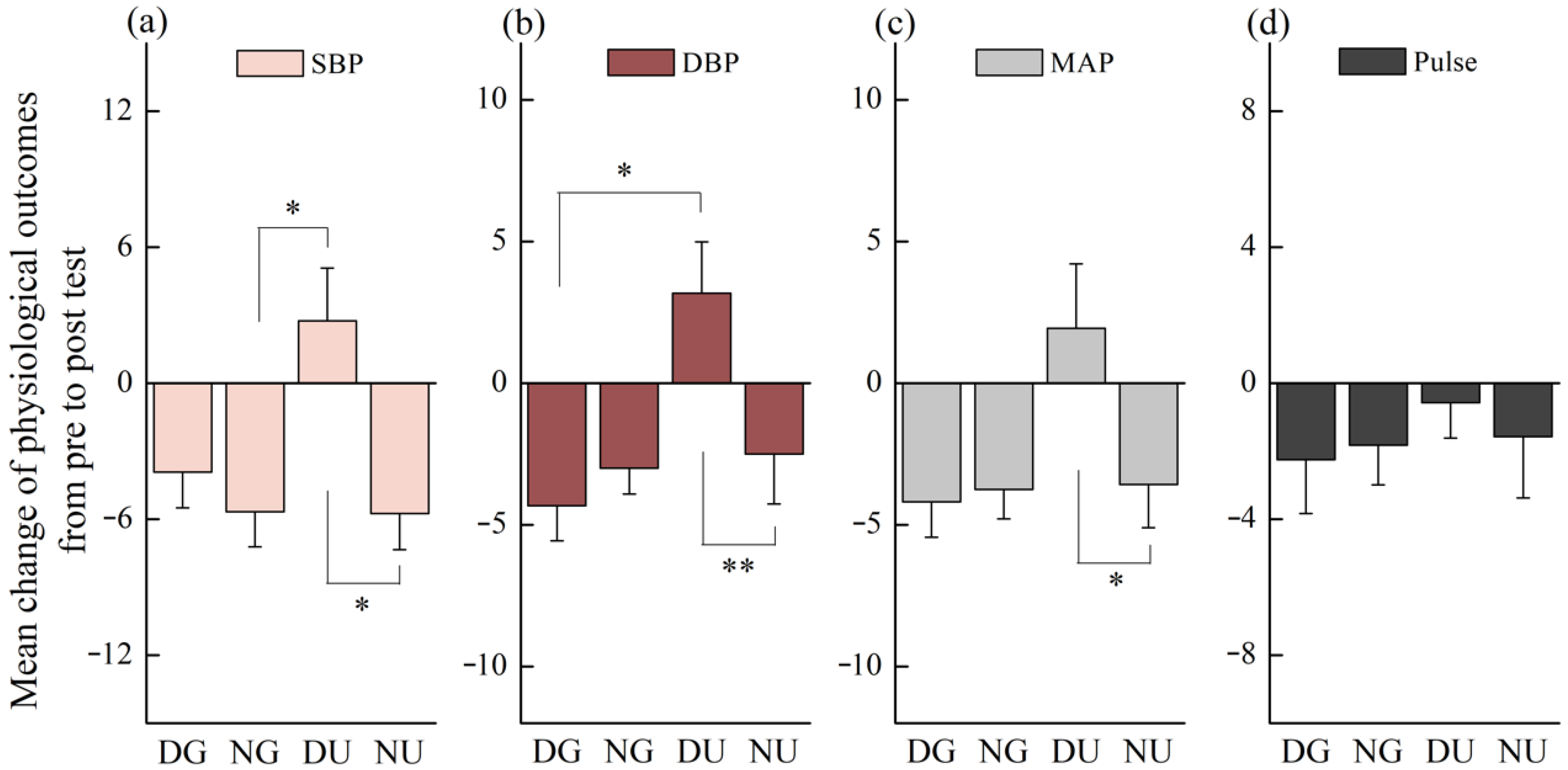

| Groups | Number | Age | BMI Index |
|---|---|---|---|
| Group1 (DG) | 12 (5 males) | 56.92 ± 2.29 | 36.30 ± 0.98 |
| Group2 (NG) | 12 (4 males) | 51.50 ± 2.61 | 36.16 ± 1.16 |
| Group3 (DU) | 12 (3 males) | 56.41 ± 2.79 | 34.79 ± 1.55 |
| Group3 (NU) | 12 (4 males) | 53.42 ± 2.60 | 35.95 ± 1.31 |
| Time | Daytime Walking (3:30–5:00 PM) | Nighttime Walking (8:30–10:00 PM) | ||
|---|---|---|---|---|
| Day 1 | Green Walking | Green Walking | ||
| Day 2 | Urban Walking | Urban Walking | ||
| Test | Psychological Item | Measuring Time | Physiological Item | Measuring Time |
| Pre-test | PANAS, POMS | 15 min before walk | SBP, DBP, Pulse rate | Just before walk |
| Post-test | PANAS, POMS, PRS, ROS | Immediately after walk | SBP, DBP, Pulse rate | 15 min after walk |
| Group | Illumination (lx) | Humidity (%) | Temperature (°C) | Noise (dB) | AQI |
|---|---|---|---|---|---|
| DG | 3510.67 ± 192.21b | 63.27 ± 1.4a | 21.73 ± 0.21a | 46.33 ± 1.23a | 18 |
| NG | 8 ± 3.64a | 71.07 ± 1.46b | 19.02 ± 0.21c | 45.33 ± 1.87a | 23 |
| DU | 7982.5 ± 1642.74c | 67.83 ± 1.16b | 19.6 ± 0.13b | 60.83 ± 2.12c | 19 |
| NU | 29.5 ± 7.41a | 78.25 ± 0.73c | 17.5 ± 0.14d | 52.17 ± 0.54b | 25 |
| Parameter | Cronbach’s α | |||
|---|---|---|---|---|
| DG | NG | DU | NU | |
| PANAS | 0.76 | 0.77 | 0.82 | 0.73 |
| POMS | 0.56 | 0.86 | 0.94 | 0.84 |
| PRS | 0.95 | 0.88 | 0.96 | 0.80 |
| ROS | 0.62 | 0.69 | 0.78 | 0.93 |
| Psychological Parameter | DG | NG | DU | NU | p |
|---|---|---|---|---|---|
| PANAS-Positive | 9 (75%) | 7 (58.3%) | 3 (25%) | 7 (58.3%) | p = 0.084 |
| PANAS-Negative | 3 (25%) | 1 (8.3%) | 1 (8.3%) | 1 (8.3%) | p = 0.693 |
| POMS-TMD | 8 (66.7%) | 8 (66.7%) | 3 (25%) | 11 (91.7%) | p = 0.10 |
| df | F | p | |
|---|---|---|---|
| Site | 1 | 16.418 | <0.001 |
| Time | 1 | 0.701 | 0.407 |
| Site × Time | 1 | 4.885 | 0.032 |
| Physiological Parameter | DG | NG | DU | NU | p |
|---|---|---|---|---|---|
| SBP | 11 (91.7%) a | 11 (91.7%) a | 4 (33.3%) b | 9 (75%) ab | p = 0.002 |
| DBP | 11 (91.7%) a | 11 (91.7%) a | 5 (41.7%) a | 11 (91.7%) a | p = 0.005 |
| MAP | 11 (91.7%) a | 11 (91.7%) a | 4 (33.3%) b | 10 (83.3%) ab | p = 0.004 |
| Pulse rate | 6 (50%) a | 8 (66.7%) a | 7 (58.3%) a | 9 (75%) a | p = 0.753 |
Publisher’s Note: MDPI stays neutral with regard to jurisdictional claims in published maps and institutional affiliations. |
© 2020 by the authors. Licensee MDPI, Basel, Switzerland. This article is an open access article distributed under the terms and conditions of the Creative Commons Attribution (CC BY) license (http://creativecommons.org/licenses/by/4.0/).
Share and Cite
Li, H.; Liu, H.; Yang, Z.; Bi, S.; Cao, Y.; Zhang, G. The Effects of Green and Urban Walking in Different Time Frames on Physio-Psychological Responses of Middle-Aged and Older People in Chengdu, China. Int. J. Environ. Res. Public Health 2021, 18, 90. https://doi.org/10.3390/ijerph18010090
Li H, Liu H, Yang Z, Bi S, Cao Y, Zhang G. The Effects of Green and Urban Walking in Different Time Frames on Physio-Psychological Responses of Middle-Aged and Older People in Chengdu, China. International Journal of Environmental Research and Public Health. 2021; 18(1):90. https://doi.org/10.3390/ijerph18010090
Chicago/Turabian StyleLi, Hansen, Haowei Liu, Zongqian Yang, Shilin Bi, Yang Cao, and Guodong Zhang. 2021. "The Effects of Green and Urban Walking in Different Time Frames on Physio-Psychological Responses of Middle-Aged and Older People in Chengdu, China" International Journal of Environmental Research and Public Health 18, no. 1: 90. https://doi.org/10.3390/ijerph18010090
APA StyleLi, H., Liu, H., Yang, Z., Bi, S., Cao, Y., & Zhang, G. (2021). The Effects of Green and Urban Walking in Different Time Frames on Physio-Psychological Responses of Middle-Aged and Older People in Chengdu, China. International Journal of Environmental Research and Public Health, 18(1), 90. https://doi.org/10.3390/ijerph18010090





